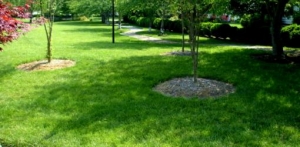 5 Tips for Greener Summer Grass…When temperatures are scorching and the sun appears to be taking its fury out on that once-healthy knoll between your sidewalk and front door, staying “green” can seem an ambitious endeavor. Here are some do-it-yourself lawn care tips from KSL.com
5 Tips for Greener Summer Grass…When temperatures are scorching and the sun appears to be taking its fury out on that once-healthy knoll between your sidewalk and front door, staying “green” can seem an ambitious endeavor. Here are some do-it-yourself lawn care tips from KSL.com
Know how to mow
If you’re ready for healthy, green grass, it’s time to commit to that lawn mower. While you might be tempted to cut the grass super short and stretch out the time between mowing, this won’t give you the green grass you covet. Grass that’s cut super short grows faster — and requires more water and herbicides to remain healthy and green. Not to mention that longer grass grows deeper roots, giving it the strength to remain healthy with less effort. Never cutting more than a third of the grass’s length at a time. Additionally, you should make sure your mowing blades are sharpened at the beginning of the season. Dull blades can rip grass instead of cutting it clean, which can encourage disease and pests.
Don’t mess with wet grass
Sure, your lawn needs to be watered on a regular basis. But when grass is wet, it’s best to leave it alone. Mowing wet grass can compact the soil and suffocate the roots, which in turn can kill the lawn you’re trying to perfect. You should also never let the sun go down on a wet lawn. Grass needs to dry out prior to dew falling, since the constant moisture can cause rot and disease.
Water deeply and infrequently
When temperatures rise, you may be tempted to sprinkle the lawn on a near- constant basis. But frequent, shallow watering actually encourages shorter root growth, which prevents grass from withstanding disease and drought. Instead, water more infrequently, but water deeply. According to Scotts Miracle-Gro, giving your lawn an inch of water per week is a good rule of thumb for the summer months.
Be judicious with the fertilizer
Yes, fertilizer can help your lawn thrive. That said, using too much fertilizer can encourage your grass to grow faster than you’d like — requiring increased mowing, watering and pesticides to keep it healthy. Not to mention that excessive fertilizer use can be harmful to the environment. To choose the right fertilizer, msn.com recommends sending a soil sample to a local lab once every four years to determine its contents. The amounts of nitrogen, phosphorus, salts and other matter in the soil will help you determine exactly which fertilizer to use.
Shake up the routine
Ever get tired of mowing repeatedly in the same pattern? Well, so does your grass. Mowing the same direction over and over again can actually compact soil and produce ruts and other problems. If you tend to mow right to left, horizontally, get a little crazy and take things vertically and from the left.
Conclusion
Use this tips to have a green lawn in the Minnesota hot summer month.
